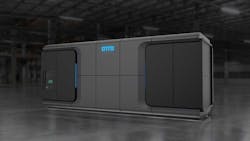New Liquid Cooling Designs Refine Options for Data Centers
Last week in our special report series, we discussed how liquid cooling adoption has evolved over time. This week, we’re looking at new liquid cooling designs, standards, and liquid cooling systems that are helping mitigate risks and alleviate challenges around data center cooling.
Download the full report.
The evolution of the workloads that we use every day to stay productive has fundamentally changed. New requirements around efficiency and using space wisely mean that leaders in the technology space need to look at cooling differently. Due to higher densities, specific heat capacities, and thermal conductivities, liquids are generally much better cooling agents than, for example, gases. Compared to air, water has a heat-carrying capacity 3,500 times higher than air and a thermal conductivity 24 times greater. This makes liquid cooling far more efficient than air cooling in the right use-cases. Specifically when the density of the environment starts to grow.
When working with liquid cooling, it’s important to note that there are different types to consider. Generally speaking, there are two different types of data center liquid cooling solutions:
Indirect Liquid Cooling (cold plate, chilled plates). Heat sinks and chill and cold plates are frequently used in high-power electrical systems. Both these systems provide a flat, cooled surface for the integration of electrical equipment. Heat is transferred from the integrated component to the cooled surface by conduction. Heat is then transferred conductively through the heat sink/ chill plate to the cooling medium.
Direct Liquid Cooling (immersion). An immersed liquid-cooled system puts the heat-producing components into direct contact with a cooling liquid. Heat travels directly to the liquid through convection. Heat can be removed from the coolant in several ways. The coolant can be pumped to a heat exchanger, then cooled and recirculated. Alternatively, heat can transfer passively from the liquid to the enclosure, with the enclosure cooling by natural convection to the surrounding air; this is how power transformers on utility power lines are cooled.
Compared to air, water has a heat-carrying capacity 3,500 times higher than air and a thermal conductivity 24 times greater. This makes liquid cooling far more efficient than air cooling in the right use-cases.
Beyond these two high-level definitions of liquid cooling, we dive into a bit more detail. The following chart covers the components of liquid cooling based on the two definitions above and their applications in the data center.
Data center cooling classification
Looking further, the chart below examines the various data center cooling methodologies and their corresponding use-cases. Interestingly, some of the most advanced development around liquid cooling revolves around immersion cooling mechanisms. New designs produce all-on-one systems as integrated components to support massive amounts of density, alongside critical data center components like network, storage, compute, and power.New Designs for Integrated Liquid Cooling Solutions
(Source: TMGcore)
Similarly, new integrated liquid cooling solutions provide the same degree of highly efficient, two-phase liquid immersion-cooled data center capacity with a smaller footprint for applications outside the core. These types of platforms support 120kW of power and 20 OIU capacity.
Finally, for smaller footprints or edge ecosystems, you can deploy specifically integrated liquid cooling solutions for applications that benefit from compute power on the front lines, close to facilities, events, or incidents. These dense, smaller platforms are purpose-built to serve as the ideal ecosystem for these applications.
(Source: TMGcore)
Remember, these technologies come built-in with the core components required to run a liquid cooling ecosystem. Again, network, storage, compute, and power can all integrate into this system. So, referencing the chart above, you’re not using component-based liquid cooling that may require a data center overhaul. Instead, you can drop these all-in-one systems into almost any type of data center ecosystem and have a self-contained liquid cooling platform.
With this in mind, and as you go on your liquid cooling journey, there are two key points to keep in mind, according to the special report.
- Vendor considerations. In the past, liquid cooling was a bit more of a puzzle piece configuration. That is, you would install only what you needed, retrofit parts of your data center, and operate independently with a given vendor. Today, liquid cooling solutions take an integrated approach where your entire use case can be encompassed in a single liquid-cooled compute pod. As exciting as that might seem, this is also an excellent opportunity to get to know your vendors and what they can do for your data center. Although these new types of integrated pods are far easier to deploy into a data center than ever before, it’s still important to validate and challenge your vendors. More so, running pilot programs and small-scale proofs-of-concept will help you learn more about these systems and how they fit into your data center.
- Serviceability. Ensuring your systems are up and running is a persistently challenging task. Now, throw in some liquids into the standard data center maintenance equation, and it can get more complicated. In liquid cooling, you would often need to find partners that can service critical components of your liquid-cooled ecosystem. So, you would have one vendor examine why a liquid-cooled component isn’t working properly, while an entirely different partner might need to examine why the rest of the server is failing. This division of duties can be cumbersome and, in some cases, risky. The difference with fully integrated systems is that you can now leverage one partner to support your liquid cooling needs. So, it would be best to look for a full scope of infrastructure monitoring and management services for a fully integrated liquid cooling solution that incorporates power, servers, networking, and storage. These services can include ensuring that all aspects of the integrated liquid-cooled platform are operating at optimal efficiency. Similarly, a partner can leverage data-driven metrics to assist with the routine maintenance of the platform proactively and even monitor the customer’s operational workloads. From there, the partner is capable of ensuring that any issues are detected, escalated, and resolved.
The liquid cooling myth busting section
In the past, specific components of the data center ecosystem were complicated to cool with liquids. Some of the biggest challenges in deploying liquid cooling revolved around spinning media and switching technologies. This was the main reason why component-based liquid cooling was beneficial. That is, you could cool only the parts of a server or infrastructure that you needed. The challenge is that you’d need to retrofit parts and pieces of your data center to support this. In examining immersion cooling, we continue to see similar challenges around hard drives and networking equipment. Consider the chart below.By utilizing atmospheric systems, TMGcore alleviates the need for heavy-duty seals, reduces the chance of leakage, and greatly reduces the complexity of the overall design.
To better understand liquid cooling and specific challenges, let’s discuss industry concerns and how new liquid cooling technologies are helping mitigate risks and alleviate challenges. The following list is a collection of the top 10 concerns and how they are being overcome with new and modern liquid cooling solutions.
(Source: TMGcore)
Large-scale computing is actually one of the last energy-intensive operations that are not cooled by liquids. Everything from nuclear reactors, car engines, paper mills, and more are already cooled with liquids.
Finally, one of the most common concerns regarding immersion cooling is cost. Interestingly, with new and modern solutions, this has become a misnomer. Two-Phase Immersion Cooling seems complex and expensive. However, given the expanding amount of use-cases, this type of immersion cooling is far easier to deploy and is less costly. For example, TMGcore has systems that can be deployed in the 2-3 dollar per watt range, including fluid and compute. The fluid cost can seem like a significant CapEx. However, the fluid is warrantied by the supplier, and partners like TMGcore provide a fluid loss guarantee on their systems and offer warranty options on the servers. To make sure you reduce both cost and complexity, be sure to work with immersion cooling partners that provide this level of service and guarantee.
As we discussed in the previous article, greater levels of density directly translate to increased savings when using liquid cooling. Compared to the traditional data center at 10 kW/rack, a 2x compaction (20 kW/rack) results in a first cost savings of 10%. When 4x compaction is assumed (40 kW/rack), savings go up to 14%.
As liquid cooling systems continue to play a role in emerging roles in new and innovative use-cases, it’s important to note that these integrated solutions have come a long way. Not only are they leveraging all-in-one design concepts, but they’re also using robotics to automate server and component maintenance further while operating in a liquid-cooled ecosystem.
Download the full report, “The State of Data Center Cooling: A Key Point in Industry Evolution and Liquid Cooling” courtesy of TMGcore to learn how new data center and business requirements are shaping digital infrastructure. In our next article, we’ll look at how liquid cooling can be integrated in data centers and at the edge. Catch up on the previous articles here and here.
About the Author


